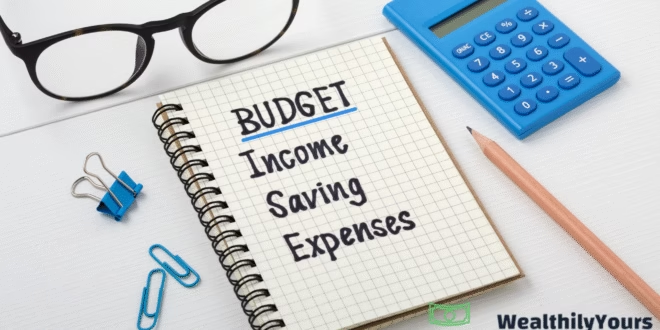A solid budgeting strategy is the backbone of financial wellness, and the popular 50/30/20 rule offers an easy-to-follow framework. In this guide, we will dive into what makes this budgeting strategy effective, how to allocate your income correctly, and why thousands adopt this balanced approach each year.
By exploring money management plan, budgeting rule breakdown, spending categories advice, and savings goal setting, you’ll master a budgeting strategy that works for you.
How the 50/30/20 Budgeting Strategy Works
Implementing a budgeting strategy using the 50/30/20 rule requires understanding three simple slices of your income:
- 50% Needs – Essentials like rent, groceries, utilities, transport
- 30% Wants – Dining out, entertainment, non-essential shopping
- 20% Savings and Debt Repayment – Emergency fund contributions, pension, or loan payments
Also Read: How to achieve financial freedom
This clear structure makes it the perfect budgeting rule for beginners, simple, effective, and easy to follow.
Budgeting Strategy: Allocating the 50% for Needs
Your money management plan starts with categorising your essential costs.
Essential bills and fixed costs
Cover rent, council tax, energy, water, transport, insurance and essential groceries. Use a spending categories advice style to fine-tune your need-based budget.
Why 50% Is Ideal
Limiting needs to half of your income ensures you aren’t overcommitted. This personal finance budgeting rule promotes healthy spending without feeling deprived.
Also Read: Why is it never late to start investing?
Budgeting Strategy: Using the 30% for Wants
The 30% slice gives you freedom, without guilt.
Enjoyment and treats
Allocate money for streaming, holidays, takeaway nights, and hobbies. This part of your budgeting strategy keeps you motivated and balanced.
Upsides of Planned Flexibility
By budgeting for enjoyment, you avoid overspending or impulse splurges. Remember, this rule is not about deprivation, it’s about mindful pleasure.
Budgeting Strategy: 20% for Savings and Debt
This segment reinforces long-term financial resilience.
Also Read: How to manage money in your 30s?
Emergency fund and savings goals
Prioritise creating a safety net, retirement contributions, or big-ticket items like a deposit or car.
Debt repayment priority
Focus on paying down high-interest debts within the 20% portion of your budgeting strategy. As debts fall, repurpose that cash into saving or investing.
Common Adjustments to the Budgeting Strategy
Life isn’t always predictable; tweak the rule for your situation.
High-cost living areas: If rent or childcare overshoots 50%, offset by trimming your 30% wants and growing income.
Freelancers and variable earners: Base your budget on average income, then allocate using the 50/30/20 model. Prepare for leaner months by saving a slightly higher share.
Also Read: How to overcome your fear of investing?
Budgeting Strategy Tools
Using the right tools enhances your budgeting strategy:
- Budget planner apps such as YNAB or Money Dashboard
- Expense tracker tools to monitor spending categories
- Savings goal tracker for the 20% portion
Real-Life Example: Applying the Budgeting Strategy
Example: Monthly take-home pay £2,400
- £1,200 for Needs – Rent, utilities, transport
- £720 for Wants – Meals out, streaming, hobbies
- £480 for Savings/Debt – £200 to emergency fund; £280 to student loan
By observing this budgeting strategy, you maintain balance: enjoy life now, while investing in your future.
Also Read: How to retire early in the UK?
Benefits of This Budgeting Strategy
- Clarity and transparency – Easy to understand and apply
- Balanced lifestyle – No guilt for spending on pleasures
- Financial security – Consistent saving and debt focus
- Flexibility – Tweak percentages to fit your life demands
Potential Limitations of the 50/30/20 Rule
- While powerful, this budgeting strategy isn’t perfect for everyone.
- Not ideal if essential costs exceed 50%
- Doesn’t fully account for large irregular expenses (e.g. tax bills)
- May require reallocation for self-employed or commission-based incomes
Tips to Enhance Your Budgeting Strategy
- Track expenses weekly to ensure compliance
- Use bank notifications alerting you when budgets deviate
- Automate your saving into a separate account each month
- Review and refine your percentages every quarter
FCA Disclaimer
This article is intended for informational purposes only and does not constitute financial advice. Always consult a Financial Conduct Authority (FCA) regulated advisor before making significant financial decisions or adopting any budgeting or debt-repayment methods.
Also Read: Learn about the snowball effect of compounding – turn your first 100000£ into a cash machine
Conclusion: Budgeting Strategy That Works
The 50/30/20 rule stands as a proven budgeting strategy, easy to implement, balanced and flexible. Whether you’re a beginner looking into a budgeting rule for beginners or someone aiming to rebalance their money management plan, this strategy helps you live well now while securing your financial future. Start allocating your earnings today: 50% to essentials, 30% for enjoyment, and 20% to savings and debt, your money, organised and purposeful.
Enjoyed the Post? Share Your Thoughts and Spread the Word!
If you found this blog post informative and helpful, I’d love it if you could share it with your friends, family, or anyone who might benefit from it. Your support helps me reach more readers and continue creating content like this!
Also, I’d love to hear from you! What are your thoughts on the topic? Do you have any questions or insights to add? Drop a comment below - I’m here to chat and learn from your perspective too.
Thank you for being part of this journey, and I can’t wait to hear what you think!
 WealthilyYours Empowering You to Grow, Invest, and Thrive
WealthilyYours Empowering You to Grow, Invest, and Thrive



